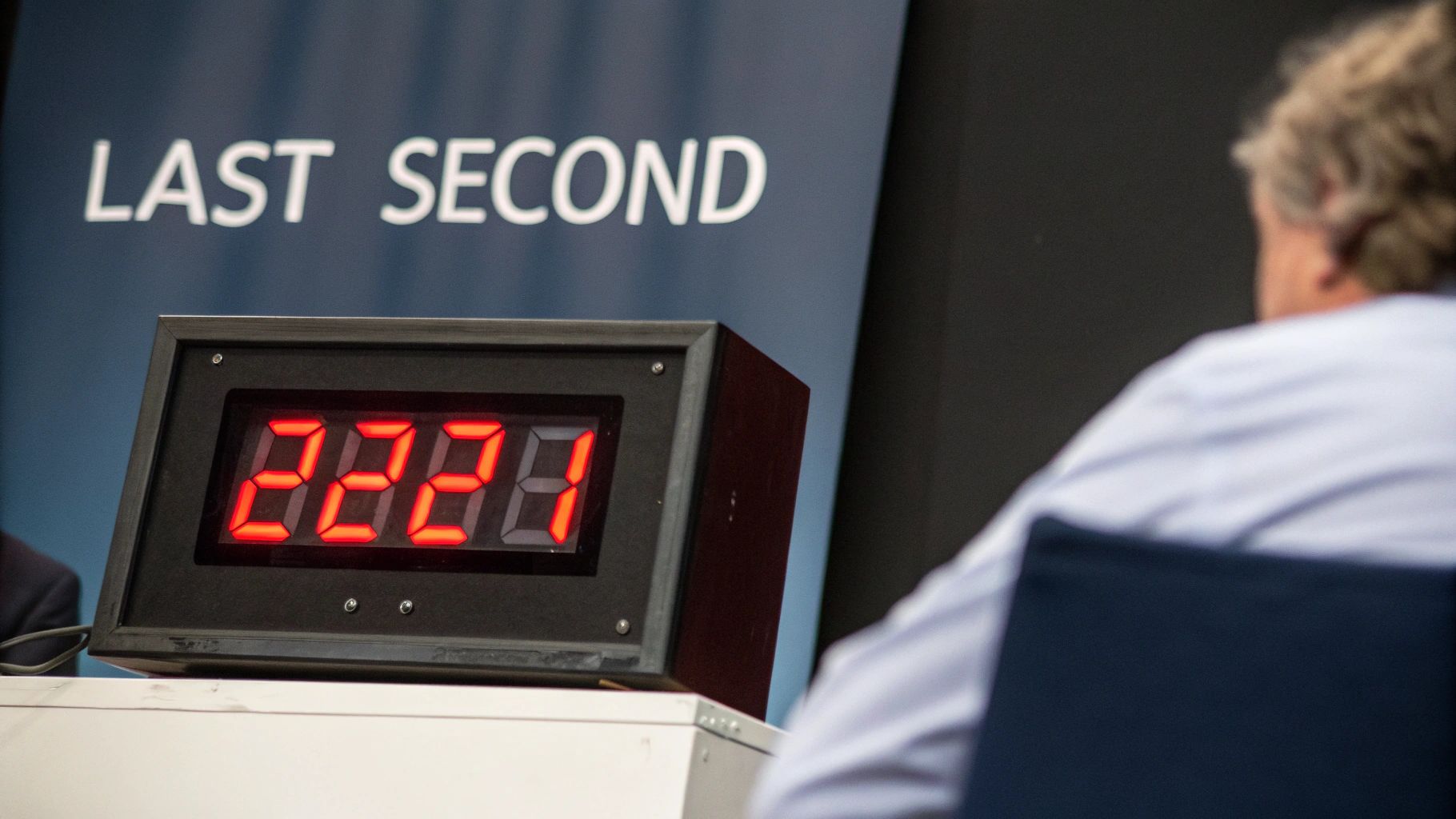
8 Expert Auction Bidding Tips for Winning
Boost your chances in 2025 with expert auction bidding tips. Learn strategies like proxy and jump bidding to win big at auctions.


Boost your chances in 2025 with expert auction bidding tips. Learn strategies like proxy and jump bidding to win big at auctions.

Want to win at auctions without overpaying? This listicle provides eight essential bidding tips to help you secure your desired property. Learn effective strategies like proxy bidding, sniping, and value-based bidding to gain a competitive edge. Understanding these concepts is crucial for navigating the fast-paced auction environment and achieving your real estate goals, whether you're a seasoned investor or a first-time buyer. Master these techniques and bid with confidence.
Proxy bidding is a powerful tool that allows you to participate in auctions without needing to constantly monitor the bidding activity. It works by allowing you to set a maximum bid – the highest price you're willing to pay for an item. The auction platform’s system then automatically bids on your behalf, incrementally increasing your bid only when necessary to outbid other participants. Importantly, your maximum bid remains hidden from other bidders. This strategy is particularly prevalent in online auctions, offering a convenient and strategic approach to acquiring desired items.

Proxy bidding deserves a top spot on this list due to its effectiveness in securing auction wins while mitigating common bidding pitfalls. It’s especially relevant for busy professionals, investors, and anyone seeking a more strategic approach. Whether you're a seasoned property investor looking for off-market deals, a first-time homebuyer navigating the market, or a downsizing baby boomer searching for the perfect property in a top school zone, proxy bidding can be a valuable asset. Specifically, its automated nature and privacy features allow you to compete effectively without the pressure and time commitment of traditional bidding.
Features of proxy bidding include: automated bidding up to your preset maximum, incremental bid increases only as needed to maintain the highest bid, and privacy of your maximum bid amount. It’s a common feature on most online auction platforms. The benefits are clear: time-saving by eliminating constant monitoring, prevention of emotional overbidding in the heat of the moment, and the assurance that you won't miss out on a desired item due to timing issues or other commitments.
However, proxy bidding is not without its drawbacks. One significant risk is setting your maximum bid too high without sufficient research. This can lead to paying more than necessary, especially if the system bids up to your maximum. Also, employing a proxy bid removes the flexibility to adjust your strategy based on the unfolding dynamics of the auction. Finally, although rare, there's always the potential for technical failures in automated systems.
Examples of successful proxy bidding implementations abound. eBay's automatic bidding system is perhaps the most widely recognised example. Prestigious auction houses like Sotheby's and Christie's also employ proxy bidding, often referred to as "absentee bidding," to facilitate remote participation in high-value art auctions. Even Amazon utilizes automated bidding features in its marketplace platform.
Actionable Tips for Using Proxy Bidding:
By understanding the mechanics of proxy bidding, its advantages and disadvantages, and by employing these tips, you can leverage this powerful tool to increase your chances of success in the auction arena, whether you're bidding on a unique collectible or your dream home.
Sniping is a bidding tactic employed in timed online auctions, particularly effective on platforms like eBay. It involves placing your bid in the final seconds of the auction, aiming to win the item without giving other bidders enough time to react and counter-bid. This strategy seeks to avoid the escalating price wars common in traditional bidding, allowing you to potentially secure the item at a lower price. This works because many bidders tend to engage early on, driving up the price incrementally. The sniper, however, lies in wait, entering the fray only at the last moment, swooping in to potentially snatch the prize. Sniping is about precise timing and a well-calculated maximum bid.

Sniping deserves its place on this list because it offers a powerful counter-strategy to traditional bidding and automated proxy bidding systems. It empowers bidders to potentially save money and avoid drawn-out bidding wars, particularly beneficial for sought-after items. The element of surprise gives snipers a psychological edge.
Examples of Successful Sniping:
When and Why to Use Sniping:
Sniping is most effective in timed online auctions, especially when competing for popular items likely to attract multiple bids. It's particularly useful when you have a specific maximum price in mind and want to avoid the emotional escalation of a bidding war. Consider sniping if you are confident in your valuation of the item and believe you can secure it below market value. This strategy is also effective against automated proxy bidding systems which incrementally increase bids up to a pre-set maximum.
Pros:
Cons:
Tips for Effective Sniping:
Specifically for the AU audience: Be mindful of time zone differences when participating in international auctions. Ensure you correctly calculate the closing time in your local AU time to avoid missing out. Also, be aware that some AU-based auction sites might have specific rules regarding bidding practices. Always check the terms and conditions.
Value-based bidding is a disciplined approach to auction participation that prioritizes objective valuation over emotional impulses. It involves conducting thorough research to determine an item's true market value and setting a maximum bid reflecting your personal value threshold before the auction begins. This pre-determined limit is adhered to strictly, regardless of the auction's competitive dynamics. This strategy removes the risk of overpaying due to emotional attachment or getting caught up in the excitement of the bidding process.

This method deserves a place on this list because it offers a powerful framework for making informed decisions in the often heated environment of an auction. Whether you're a seasoned property investor, a first-time homebuyer, or a collector of rare antiques, value-based bidding can protect your financial interests and lead to more successful acquisitions. Its systematic approach applies to various auction scenarios, from high-stakes art auctions to competitive real estate bidding. Key features include comprehensive pre-auction research, strict adherence to pre-set maximum bids, and a focus on objective value rather than auction psychology. By applying systematic valuation methods and factoring in post-auction costs (like renovations for a property or restoration for an antique), you gain a clear picture of the true cost of acquisition.
For instance, imagine a property auction in Sydney. A value-based bidder would thoroughly research recent comparable sales in the area, consider the property's condition and potential for future growth, calculate potential rental yields, factor in stamp duty and other associated costs, and arrive at a maximum bid. This bidder wouldn't be swayed by the competitive energy of the auction room if the bidding surpasses their predetermined limit. Similarly, professional car buyers at Barrett-Jackson auctions employ meticulous value assessments, ensuring they acquire vehicles at prices aligned with market realities.
Actionable Tips for Value-Based Bidding:
Pros and Cons of Value-Based Bidding:
Pros:
Cons:
Value-based bidding is particularly beneficial for those who prioritize rational decision-making and long-term value. Whether you're a seasoned property investor seeking high-yield opportunities, a first-time homebuyer navigating the market, or a discerning collector of fine art, this method empowers you to make informed decisions, avoid costly mistakes, and achieve your auction goals.
The opening bid strategy is a crucial tactic in any auction, dictating the initial momentum and potentially influencing the final price. It revolves around strategically placing your first bid – whether it's the minimum, a significantly higher amount, or even holding back entirely. Each approach carries its own psychological and economic impact on the other bidders and the auction's trajectory. This strategy is particularly relevant in the Australian property market, where competition can be fierce and understanding the nuances of bidding can make a significant difference.
This strategy deserves a place on this list because mastering the opening bid can give you a significant advantage, whether you're bidding on a family home in a coveted school zone, an investment property, or even smaller items like furniture at a clearing sale. It allows you to set the tone, signal your intentions, and potentially deter other bidders.
How it Works:
The opening bid strategy involves analyzing the specific auction context, including the item's value, the level of competition, and the auction format. Based on this assessment, you choose an opening bid designed to achieve a specific outcome.
Features and Benefits:
Pros:
Cons:
Examples of Successful Implementation:
Actionable Tips for Australian Buyers:
When and Why to Use This Approach:
The opening bid strategy is essential in any competitive auction environment. It's particularly valuable when:
By understanding the nuances of the opening bid strategy and applying it judiciously, you can significantly improve your chances of auction success in the Australian market.
Incremental bidding is a strategic approach to auction bidding where you place multiple small bid increases at the minimum allowed increment, rather than making large jumps. This methodical approach aims to secure the desired item at the lowest possible price while simultaneously gathering valuable intelligence about your competition. It's a game of patience, persistence, and subtle psychological pressure.
This technique deserves its place in this list because it offers a powerful alternative to aggressive bidding, especially in scenarios where understanding your competition and managing your budget are paramount. Instead of potentially overpaying with a large initial bid, incremental bidding allows you to carefully test the waters and adjust your strategy in real-time.
How it Works:
Incremental bidding involves consistently engaging throughout the auction. Each bid you place, though small, serves multiple purposes:
Examples of Success:
Incremental bidding is a common tactic employed by seasoned professionals across various auction types:
Actionable Tips for Incremental Bidding:
Pros and Cons:
Pros:
Cons:
When and Why to Use Incremental Bidding:
Incremental bidding is particularly suited for scenarios where:
This strategy may be less effective in fast-paced auctions or situations where quick decisions are essential. However, for the discerning bidder who prioritizes informed decisions and strategic advantage, incremental bidding can be a powerful tool in the auction arsenal.
Jump bidding is a powerful yet risky auction strategy that involves placing a bid significantly higher than the current highest bid or the minimum increment required. This bold move aims to signal your unwavering commitment to acquiring the item, potentially intimidating other bidders and swiftly ending the competition. It's a tactic that can pay off handsomely, securing the desired item quickly and potentially for a lower price than a protracted bidding war might have yielded, but it also carries the risk of overpaying. This strategy is particularly relevant in high-stakes auctions, such as those for prestigious properties in competitive markets like Sydney or Melbourne.

For property investors, first-time buyers, upgraders, and those seeking premium homes, understanding jump bidding can be crucial, especially in Australia's competitive real estate landscape. In heated auction environments, where desirable properties attract significant interest, a well-timed and calculated jump bid can be a game-changer. It demonstrates serious intent and financial capacity, which can deter less committed bidders. This can be particularly effective when bidding against first-time buyers who might be more hesitant or have stricter budget limitations. Imagine a scenario in a sought-after school zone where multiple families are vying for the same property – a jump bid can signal your unwavering commitment and potentially secure your dream home.
When and Why to Use Jump Bidding:
Jump bidding isn't always the right approach. It’s most effective at strategic moments, such as early in the auction to establish dominance or at critical decision points to break a stalemate. It's designed to create a psychological advantage. The sudden increase can unsettle other bidders, making them question their own financial limits and the strength of their desire for the item.
Pros:
Cons:
Tips for Effective Jump Bidding:
Jump bidding deserves a place on this list because, when used strategically, it can be a highly effective tool for securing a desired property, especially in competitive Australian markets. However, its potential benefits must be carefully weighed against the inherent risks. By understanding the dynamics of jump bidding and employing it judiciously, you can increase your chances of success at auction.
Collusion and lot splitting is a strategy involving secret agreements between potential bidders to suppress competition at auctions. Participants agree not to bid against each other, allowing one of them to win the item at a significantly lower price than if competitive bidding had occurred. After the auction, the colluding parties may split the item(s) or profits, or they might take turns winning different auctions. For example, one bidder might win a property at a low price due to the suppressed bidding, and then in a subsequent auction, another member of the colluding group will be allowed to win. This creates a pattern of reciprocal non-competition. While seemingly offering a path to acquiring assets at reduced prices, this practice carries significant legal and ethical risks.
This strategy might appear attractive, particularly in heated property markets like those often seen in Australia, where competition can be fierce. Imagine several investors interested in subdividing a large plot of land. They could agree beforehand not to bid against each other, allowing one of them to win at a deflated price. Later, they could split the land or profits amongst themselves. This scenario illustrates the potential financial gains of collusion. However, the risks far outweigh any perceived benefits.
Pros (illusory):
Cons (substantial and unavoidable):
Examples:
Tips:
Collusion and lot splitting has no legitimate place in the Australian property market. The severe legal ramifications and ethical implications far outweigh any potential short-term financial gains. Focus on legitimate strategies for acquiring property and seek professional legal advice when exploring investment options. This illegal tactic is included in this list not as a recommendation, but as a crucial warning. Understanding the illegality and consequences of collusion is vital for anyone participating in auctions.
Information gathering and analysis is more than just browsing a catalogue before an auction; it's a powerful strategy that can transform you from a casual bidder into a strategic buyer. It involves systematically collecting and analysing data about past auction results, bidder behaviour, market trends, and specific item details to give you a decisive edge. This preparation allows you to make informed decisions, identify undervalued items, and avoid overpaying. In the competitive AU auction landscape, this approach is essential for securing the best deals.
How it Works:
This strategy relies on diligent research and analytical thinking. It's about understanding the bigger picture: the history of the item, the behaviour of other bidders, and the overall market forces at play. This allows you to predict likely bidding patterns and develop a well-informed bidding strategy, rather than relying solely on gut feeling in the heat of the moment.
Examples of Success:
Consider Bill Gross, renowned for his extensive stamp collection. His acquisition strategy heavily relied on meticulous auction data analysis, enabling him to pinpoint valuable stamps often overlooked by others. Similarly, Heritage Auctions, a major player in the AU market, developed their HERITAGE Live! analytics platform to provide bidders with richer data and enhance their understanding of market dynamics. Professional art buyers routinely track artist price histories across global markets, illustrating the power of this approach across diverse auction categories.
Actionable Tips for AU Bidders:
When and Why to Use This Approach:
This strategy is particularly beneficial for high-value items, competitive auctions, or when you're seeking a specific and rare item. It's ideal for:
Pros and Cons:
Pros:
Cons:
Information gathering and analysis elevates auction bidding from a game of chance to a strategic pursuit. By investing time and effort in research, you gain a powerful advantage, enabling you to make informed decisions and secure the best possible deals in the dynamic AU auction market. This approach deserves its place on this list because it empowers you to bid with confidence and maximize your chances of success.
From understanding proxy bidding and the art of sniping to mastering value-based bidding and navigating the complexities of incremental and jump bids, the strategies discussed in this article provide a comprehensive toolkit for auction success. Internalising these techniques, combined with thorough information gathering and analysis (and a keen awareness of potential pitfalls like collusion and lot splitting), empowers you to bid strategically, not emotionally. These insights are crucial whether you're a seasoned property investor seeking high-yield opportunities, a first-time buyer navigating the market, or a family looking for the perfect home in a top school zone.
One of the most important takeaways is the need for a disciplined and structured approach. While focusing on individual bidding tactics is important, remember that a well-structured approach to any endeavor, including auction bidding, is crucial for consistent success. Implementing a quality assurance program can help you analyze your bidding performance, identify areas for improvement, and ultimately increase your chances of winning. By objectively reviewing your past bids and the outcomes, you can refine your strategies and avoid repeating mistakes.
Mastering these concepts translates to more than just winning bids; it means securing your dream property at the right price, minimizing stress, and maximizing your investment. It's about achieving your property goals, whether that's finding the perfect family home or building a robust investment portfolio.
Navigating the complexities of auctions can be challenging. For expert guidance and support to secure your ideal property, partner with Shayne Mele Buyers Agent. Our team provides comprehensive services, from pre-auction research and strategic bidding advice to negotiation and acquisition, ensuring you're equipped to confidently navigate the auction process and achieve your property goals.